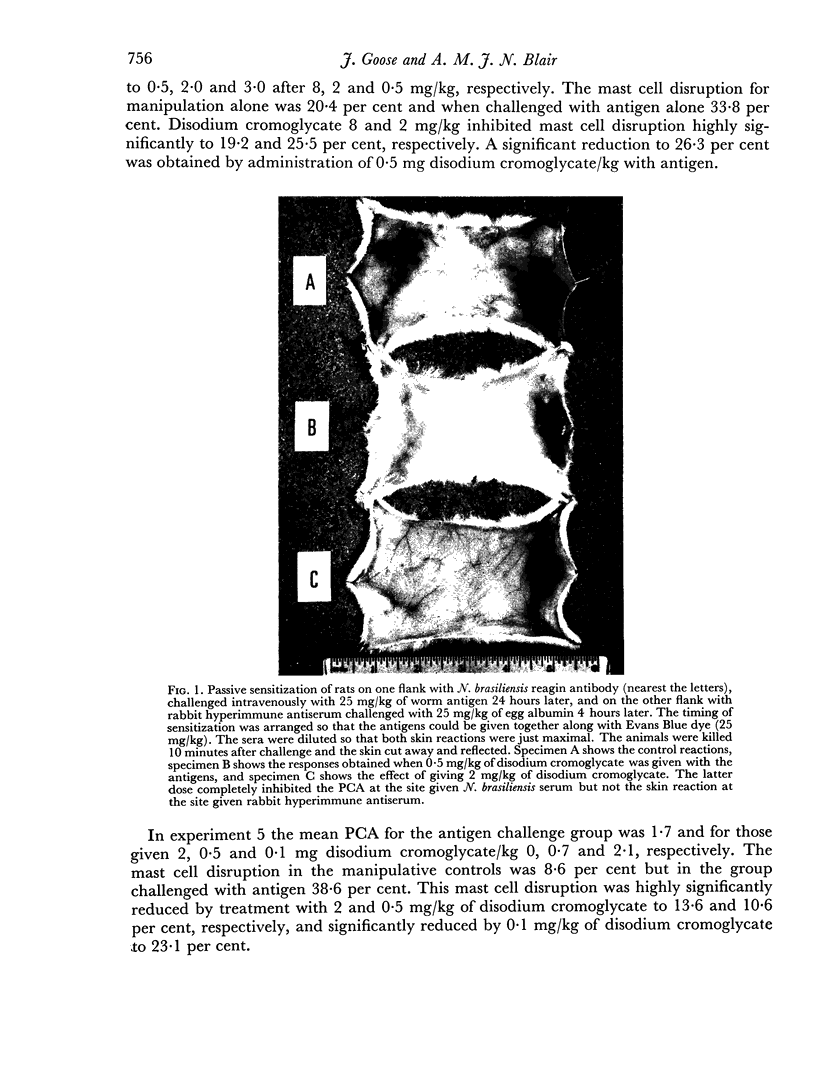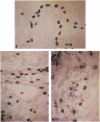Abstract
Rats immunized with egg albumin and Bordetella pertussis organisms produce a `mast cell sensitizing' antibody (MCSAb) which is thermolabile, a potent skin sensitizer and reagin in character. Similarly the immune response to Nippostrongylus brasiliensis in rats is closely associated with the formation of antibodies which also resembles human reagins. Homologous passive cutaneous anaphylactic (PCA) reactions induced by N. brasiliensis serum were found to be similar to those produced using the adjuvant induced antibody in that both were completely inhibited by, combined treatment with mepyramine and 2-bromo-D-lysergic acid diethylamide (BOL148), cyproheptadine or pretreatment with compound 48/80. In contrast, skin reactions involving passive sensitization of rats with rabbit hyperimmune antiserum were much less affected. Studies on mast cell disruption at the site of PCA reactions showed that such reactions using N. brasiliensis serum were accompanied by degranulation of mast cells, and confirmed that mast cell damage occurs in PCA induced with MCSAb. Both the PCA and the mast cell disruption were maximal 5 minutes after antigen challenge in both rat reagin systems. The skin reaction produced using rabbit hyperimmune antiserum was not primarily dependent on, or associated with, mast cell disruption, since it was still possible to induce skin reactions when the mast cells had been disrupted by compound 48/80, and skin reactions could be obtained without significant mast cell disruption.
Disodium cromoglycate, a new compound introduced for the treatment of asthma, was shown to inhibit both the PCA and mast cell disruption induced using both rat reagin antibodies but not the skin reactions produced with rabbit anti-serum. It was possible to obtain substantial inhibition of mast cell disruption induced by rat reagin, even when the PCA was inhibited only slightly. At higher doses the discharge of the mediators from mast cells was also prevented. This interference with mast cell permeability was not unspecific since disodium cromoglycate did not prevent the skin reaction or mast cell disruption produced by compound 48/80. As expected mepyramine was able to partially inhibit the skin reaction without affecting mast cell disruption induced by rat reagin or compound 48/80. It is suggested that disodium cromoglycate acts at some critical pathway in the events after the union of antigen with reagin antibody and that this critical pathway might be common to both the human and rat reagin systems.
Full text
PDF












Images in this article
Selected References
These references are in PubMed. This may not be the complete list of references from this article.
- BINAGHI R. A., BENACERRAF B. THE PRODUCTION OF ANAPHYLACTIC ANTIBODY IN THE RAT. J Immunol. 1964 Jun;92:920–926. [PubMed] [Google Scholar]
- BRIGGS N. T. IMMUNOLOGICAL INJURY OF MAST CELLS IN MICE ACTIVELY AND PASSIVELY SENSITIZED TO ANTIGENS FROM TRICHINELLA SPIRALIS. J Infect Dis. 1963 Jul-Aug;113:22–32. doi: 10.1093/infdis/113.1.22. [DOI] [PubMed] [Google Scholar]
- Becker E. L., Mota I., Wong D. Inhibition by antihistamines of the vascular permeability increase induced by bradykinin. Br J Pharmacol. 1968 Oct;34(2):330–336. doi: 10.1111/j.1476-5381.1968.tb07054.x. [DOI] [PMC free article] [PubMed] [Google Scholar]
- Bloch K. J., Wilson R. J. Homocytotropic antibody response in the rat infected with the nematode, Nippostrongylus brasiliensis. 3. Characteristics of the antibody. J Immunol. 1968 Mar;100(3):629–636. [PubMed] [Google Scholar]
- Clarke K. R. The migration route of the third stage larvae of Nippostrongylus brasiliensis (Travassos, 1914). J Helminthol. 1967;41(4):285–290. doi: 10.1017/s0022149x00021817. [DOI] [PubMed] [Google Scholar]
- Cox J. S. Disodium cromoglycate (FPL 670) ('Intal'): a specific inhibitor of reaginic antibody-antigen mechanisms. Nature. 1967 Dec 30;216(5122):1328–1329. doi: 10.1038/2161328a0. [DOI] [PubMed] [Google Scholar]
- MOTA I. THE MECHANISM OF ANAPHYLAXIS. I. PRODUCTION AND BIOLOGICAL PROPERTIES OF 'MAST CELL SENSITIZING' ANTIBODY. Immunology. 1964 Nov;7:681–699. [PMC free article] [PubMed] [Google Scholar]
- Movat H. Z., Lovett C. A., Taichman N. S. Demonstration of antigen on the surface of sensitized rat mast cells. Nature. 1966 Nov 19;212(5064):851–853. doi: 10.1038/212851b0. [DOI] [PubMed] [Google Scholar]
- OGILVIE B. M. REAGIN-LIKE ANTIBODIES IN ANIMALS IMMUNE TO HELMINTH PARASITES. Nature. 1964 Oct 3;204:91–92. doi: 10.1038/204091a0. [DOI] [PubMed] [Google Scholar]
- Pepys J., Hargreave F. E., Chan M., McCarthy D. S. Inhibitory effects of disodium cromoglycate on allergen-inhalation tests. Lancet. 1968 Jul 20;2(7560):134–137. doi: 10.1016/s0140-6736(68)90419-4. [DOI] [PubMed] [Google Scholar]




